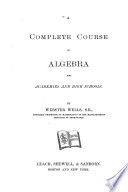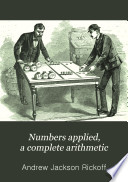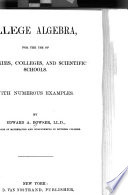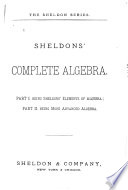 | Webster Wells - Algebra - 1885 - 382 pages
...root. Add to the trial-divisor three times the product of the first term of the root by the second, and the square of the second term. Multiply the complete divisor by the term of the root last obtained, and subtract the product from the remainder. If other terms remain,... | |
 | Webster Wells - Algebra - 1885 - 370 pages
...root. Add to the trial-divisor three times the product of the first term of the root by the second, and the square of the second term. Multiply the complete divisor by the term of the root last obtained, and subtract the product from the remainder. If other terms remain,... | |
 | Webster Wells - 1885 - 368 pages
...root. Add to the trial-divisor three times the product of the first term of the root by the second, and the square of the second term. Multiply the complete divisor by the term of the root last obtained, and subtract the product from the remainder. If other terms remain,... | |
 | Andrew Jackson Rickoff - Arithmetic - 1886 - 688 pages
...second figure of the root to the trial divisor. The result will be the complete divisor. Multiply this by the second term of the root, and subtract the product from the dividend. 6. Bepeat the operation as in 4 and 5 until the periods are all brought down. Notes, —... | |
 | Edward Albert Bowser - Algebra - 1888 - 868 pages
...by adding to the trial divisor three times the product of the first and second terms of the root and the square of the second term. Multiply the complete...root, and subtract the product from the remainder. If there are other terms remaining, take three times the square of the part of the root already found... | |
 | Algebra - 1888 - 492 pages
...second term of the root and also annexing it to the trial divisor. Multiply the divisor thus completed by the second term of the root and subtract the product from the remainder of the polynomial. III. Proceed in this manner until there is no remainder, or until the remainder... | |
 | Andrew Jackson Rickoff - 1888 - 464 pages
...second figure of the root to the trial divisor. The result will be the complete divisor. Multiply this by the second term of the root, and subtract the product from the dividend. 6. Repeat the operation as in 4 and 6 until the periods are all brought down. Notes.—1.... | |
 | James Bates Thomson - 1888 - 336 pages
...of the first term by the second, also the square of the second. Multiply the complete divisor Ъу the second term of the root, and subtract the product from the remainder. IV. If there are more than two terms in the root, for the second trial divisor, take three times the... | |
 | John Bernard Clarke - Algebra - 1889 - 566 pages
...the first term of the root. Add the quotient to the root and to the divisor. Multiply the augmented divisor by the second term of the root and. subtract the product from the first remainder. Divide the first term of the second remainder by twice the first term of the root,... | |
 | Webster Wells - Algebra - 1889 - 584 pages
...Add to the trial-divisor three times the product of the first term, of the root by the second, and the square of the second term. Multiply the complete divisor by the term of the root last obtained, and subtract the product from the remainder. If other terms remain,... | |
| |